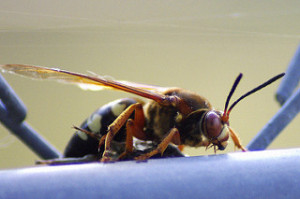If Cicadas Are Out, So Are Cicada Killer Wasps
By Chris Williams on July 28, 2015.
My daughter found a huge black, brown, and yellow hornet in our backyard. We tried to look it up on the web and it looks like a cicada killer wasp. The website says it feeds on cicadas but I haven’t seen any evidence of a cicada hatch this summer. Do cicada killer wasps feed on other things?
G. N., Merrimack, NH

Cicada Killer Wasp
No, cicada killer wasps are specialized predators on cicadas, and only on cicadas. In fact, their presence is timed to correlate with the summer emergence of cicadas. But you may be thinking about the large emergences of black periodical cicadas that occur only once every several years and are impossible to miss. We don’t have any broods of periodical cicadas scheduled to make their appearance in New Hampshire or Massachusetts this year, but we do have the green annual cicadas that show up every year in mid-summer (see Cicadas Are Making Their Appearance!).
Annual Cicadas Emerge Every Summer
Annual cicadas, sometimes called “dog day cicadas,” are around. If you listen, you can hear their modulated buzzing in the treetops. And while their numbers are much smaller than a periodical cicada hatch, you might be able to find the shed skins or shells of annual cicada nymphs left behind on tree trunks or other vertical objects. You might also be able to find two different sets of dime-sized holes in your yard. One group of holes is made by the cicada nymphs as they emerge from years spent underground. Other holes, with a mound of excavated soil nearby, are the ground nests of the cicada killer wasps.
Cicada Killer Wasps Are More Interesting Than Worrisome
Cicada killers are solitary wasps; one female digs the nest burrow and provisions it with a paralyzed cicada for her larva to feed on. It’s very interesting to watch the wasp fly to her burrow with a cicada that is just as big as she is, carried underneath her body. She can dig and provision many burrows and more than one wasp may nest in the same area. They prefer to dig burrows in sandy soil with little vegetation.
Despite their scary size (up to 2 inches long), cicada killer wasps are not at all aggressive, and are just going about their business. They are only around for a few weeks. When cicadas die near the end of the summer, the predatory wasps will be gone, too. For more on these gentle giants, see Cicada Killers Are Our Biggest Wasps.
Photo credit: Monkey Mash Button / Foter / CC BY-SA